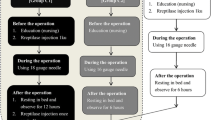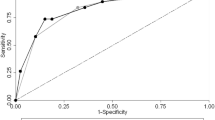Abstract
Purpose
To investigate whether BP is related to postbiopsy bleeding in patients undergoing native percutaneous kidney biopsy (PKB) and to evaluate the dynamic changes in blood pressure (BP) pre- and post-kidney biopsy.
Methods
A retrospective cross-sectional study was conducted. The whole-procedural systolic (SBP) and diastolic (DBP) BP for patients undergoing ultrasound-guided native PKB from October 2017 to December 2020 were recorded in the study. Propensity score matching was used to minimize selection bias. SBP and DBP were analyzed as the main risk factors for bleeding complications. Receiver operating characteristic (ROC) curves were employed to explore the optimal BP thresholds to differentiate between bleeding and nonbleeding. The rates of major bleeding complications were analyzed according to BP thresholds through logistic analysis.
Results
Of 1146 biopsies, 432 (37.7%) patients suffered from postbiopsy bleeding, 88 (7.7%) patients had major bleeding complications, and 344 (30.0%) patients had minor bleeding complications. In the original data, for patients with SBP ≥ 160 mmHg before PKB, the rate of major bleeding complications was 17.6% (7.5% for SBP < 160 mmHg), and the rate of major bleeding complications was 19.0% in patients with DBP ≥ 100 mmHg (7.5% for DBP < 100 mmHg). For patients with DBP ≥ 85 mmHg to 100 mmHg after PKB, the rate of major bleeding complications ranged from 9.5 to 17.5%. The rate of major bleeding complications was lower (6.6–7.3%) in patients with DBP < 100 mmHg to 85 mmHg.
Conclusion
Patients who have high-level BP during the native PKB perioperative period are at higher risk for postbiopsy bleeding. High-level BP here does not refer to traditional hypertension according to the guidelines for the diagnosis and treatment of hypertension, but rather BP above a certain threshold related to bleeding risk.
Graphical abstract


Similar content being viewed by others
References
Capitanio U, Larcher A, Fallara G, et al. Parenchymal biopsy in the management of patients with renal cancer. World journal of urology. 2021;39(8):2961-8.
Dhaun N, Bellamy CO, Cattran DC, Kluth DC. Utility of renal biopsy in the clinical management of renal disease. Kidney international. 2014;85(5):1039-48.
Botti RE, Razzak MA, MacIntyre WJ, Pritchard WH. The relationship of renal blood flow to cardiac output in normal individuals as determined by concomitant radioisotopic measurements. Cardiovascular research. 1968;2(3):243-6.
Hogan JJ, Mocanu M, Berns JS. The native kidney biopsy: update and evidence for best practice. Clin J Am Soc Nephrol. 2016;11(2):354-362.
Corapi KM, Chen JL, Balk EM, Gordon CE. Bleeding complications of native kidney biopsy: a systematic review and meta-analysis. American journal of kidney diseases : the official journal of the National Kidney Foundation. 2012;60(1):62-73.
Doyle AJ, Gregory MC, Terreros DA. Percutaneous native renal biopsy: comparison of a 1.2-mm spring-driven system with a traditional 2-mm hand-driven system. American journal of kidney diseases : the official journal of the National Kidney Foundation. 1994;23(4):498–503.
Zhu MS, Chen JZ, Xu AP. Factors that can minimize bleeding complications after renal biopsy. International urology and nephrology. 2014;46(10):1969-75.
Potretzke TA, Gunderson TM, Aamodt D, et al. Incidence of bleeding complications after percutaneous core needle biopsy in hypertensive patients and comparison to normotensive patients. Abdominal radiology (New York). 2016;41(4):637-42.
Kriegshauser JS, Patel MD, Young SW, Chen F, Eversman WG, Chang YH. Risk of bleeding after native renal biopsy as a function of preprocedural systolic and diastolic blood pressure. Journal of vascular and interventional radiology : JVIR. 2015;26(2):206-12.
Zhang, L., Li, G. L., Dang, Z. H., et al. [Analysis of bleeding risk in percutaneous renal biopsy in Tibet]. Beijing Da Xue Xue Bao Yi Xue Ban, 2021;53(2): 298-301.
Xu DM, Chen M, Zhou FD, Zhao MH. Risk Factors for Severe Bleeding Complications in Percutaneous Renal Biopsy. The American journal of the medical sciences. 2017;353(3):230-5.
Li Q, Lin X, Zhang X, Samir AE, Arellano RS. Imaging-Related Risk Factors for Bleeding Complications of US-Guided Native Renal Biopsy: A Propensity Score Matching Analysis. Journal of vascular and interventional radiology : JVIR. 2019;30(1):87-94.
Brachemi S, Bollée G. Renal biopsy practice: What is the gold standard? World journal of nephrology. 2014;3(4):287-94.
Luciano RL, Moeckel GW. Update on the Native Kidney Biopsy: Core Curriculum 2019. American journal of kidney diseases : the official journal of the National Kidney Foundation. 2019;73(3):404-15.
Patel MD, Phillips CJ, Young SW, et al. US-guided renal transplant biopsy: efficacy of a cortical tangential approach. Radiology 2010; 256: 290-296
Poggio ED, McClelland RL, Blank KN, et al. Systematic Review and Meta-Analysis of Native Kidney Biopsy Complications. Clinical journal of the American Society of Nephrology : CJASN. 2020;15(11):1595-602.
Monahan H, Gunderson T, Greene E, Schmit G, Atwell T, Schmitz J. Risk factors associated with significant bleeding events after ultrasound-guided percutaneous native renal biopsies: a review of 2204 cases. Abdominal radiology (New York). 2019;44(6):2316-22.
MacGinley R, Champion De Crespigny PJ, Gutman T, et al. KHA-CARI Guideline recommendations for renal biopsy. Nephrology (Carlton, Vic). 2019;24(12):1205–13.
Patel AG, Kriegshauser JS, Young SW, Dahiya N, Patel MD. Detection of Bleeding Complications After Renal Transplant Biopsy. AJR American journal of roentgenology. 2021;216(2):428-35.
Tomitani N, Kanegae H, Suzuki Y, Kuwabara M, Kario K. Stress-Induced Blood Pressure Elevation Self-Measured by a Wearable Watch-Type Device. American journal of hypertension. 2021;34(4):377-82.
Gavrilova L, Zawadzki MJ. Testing the Associations Between State and Trait Anxiety, Anger, Sadness, and Ambulatory Blood Pressure and Whether Race Impacts These Relationships. Annals of behavioral medicine: a publication of the Society of Behavioral Medicine. 2021;57(1):38-49.
Jelicic I. Relationship of a food intake during hemodialysis and symptomatic intradialytic hypotension. Hemodialysis international International Symposium on Home Hemodialysis. 2021;25(3):333-337.
Gardner KD, Hildreth EA. HYPOTENSION DURING PERCUTANEOUS RENAL BIOPSY. Jama-Journal of the American Medical Association. 1963;186(6):599-600.
Roccatello D, Sciascia S, Rossi D, et al. Outpatient percutaneous native renal biopsy: safety profile in a large monocentric cohort. BMJ Open 2017;7(6):e015243.
Esposito V, Mazzon G, Baiardi P, et al. Safety and adequacy of percutaneous kidney biopsy performed by nephrology trainees. BMC nephrology. 2018;19(1):14.
Gal-Oz A, Papushado A, Kirgner I, et al. Thromboelastography versus bleeding time for risk of bleeding post native kidney biopsy. Renal Failure. 2020;42(1):10-18.
Peters B, Afghahi H, Maitlo S, Hadimeri H. Risk factors for biopsy complications in initial versus subsequent biopsies in native and transplant kidneys. Acta Radiologica. 2021;62(10):1426-1432.
Stratta P, Canavese C, Marengo M, et al. Risk management of renal biopsy: 1387 cases over 30 years in a single centre. Eur J Clin Invest. 2007; 37:954–963.
Acknowledgements
This project was supported by the Peking Union Medical College Hospital nursing program (XHHLKY202004)
Author information
Authors and Affiliations
Corresponding author
Additional information
Publisher's Note
Springer Nature remains neutral with regard to jurisdictional claims in published maps and institutional affiliations.
Rights and permissions
Springer Nature or its licensor (e.g. a society or other partner) holds exclusive rights to this article under a publishing agreement with the author(s) or other rightsholder(s); author self-archiving of the accepted manuscript version of this article is solely governed by the terms of such publishing agreement and applicable law.
About this article
Cite this article
Guan, Y., Bai, C., Li, F. et al. The impact of blood pressure on the risk of postbiopsy bleeding during the whole procedure of percutaneous kidney biopsy. Abdom Radiol 48, 1140–1147 (2023). https://doi.org/10.1007/s00261-022-03781-1
Received:
Revised:
Accepted:
Published:
Issue Date:
DOI: https://doi.org/10.1007/s00261-022-03781-1




